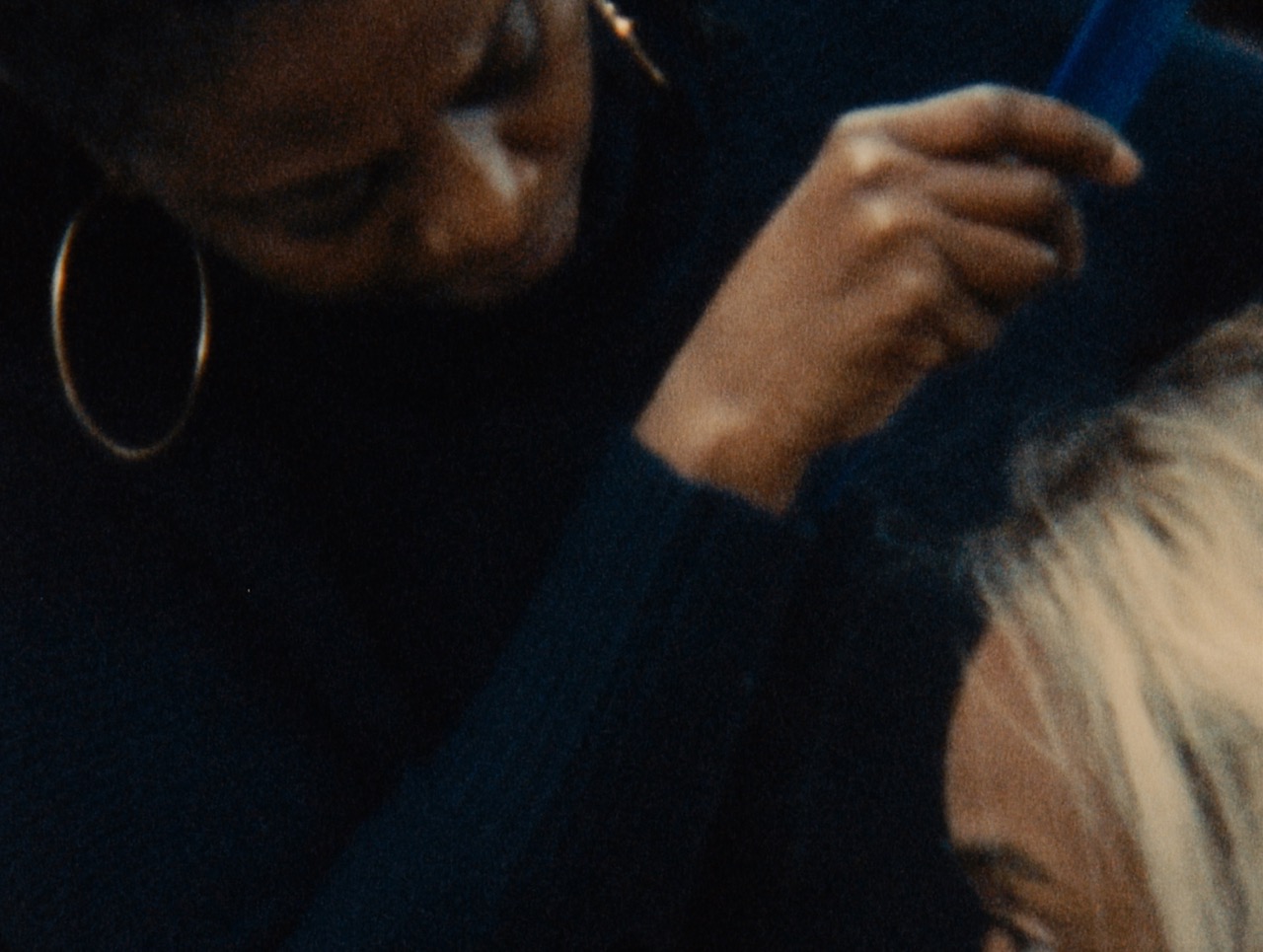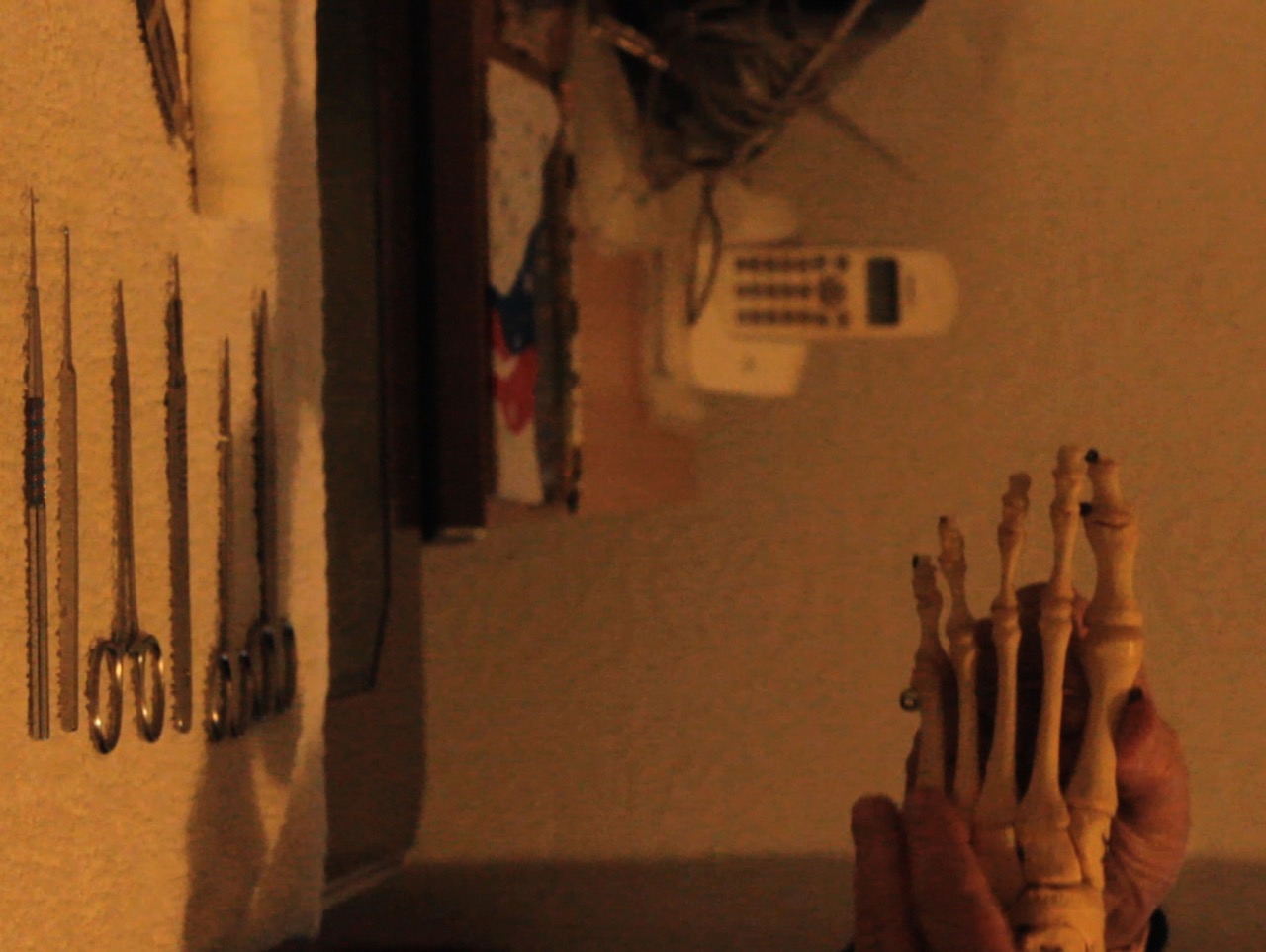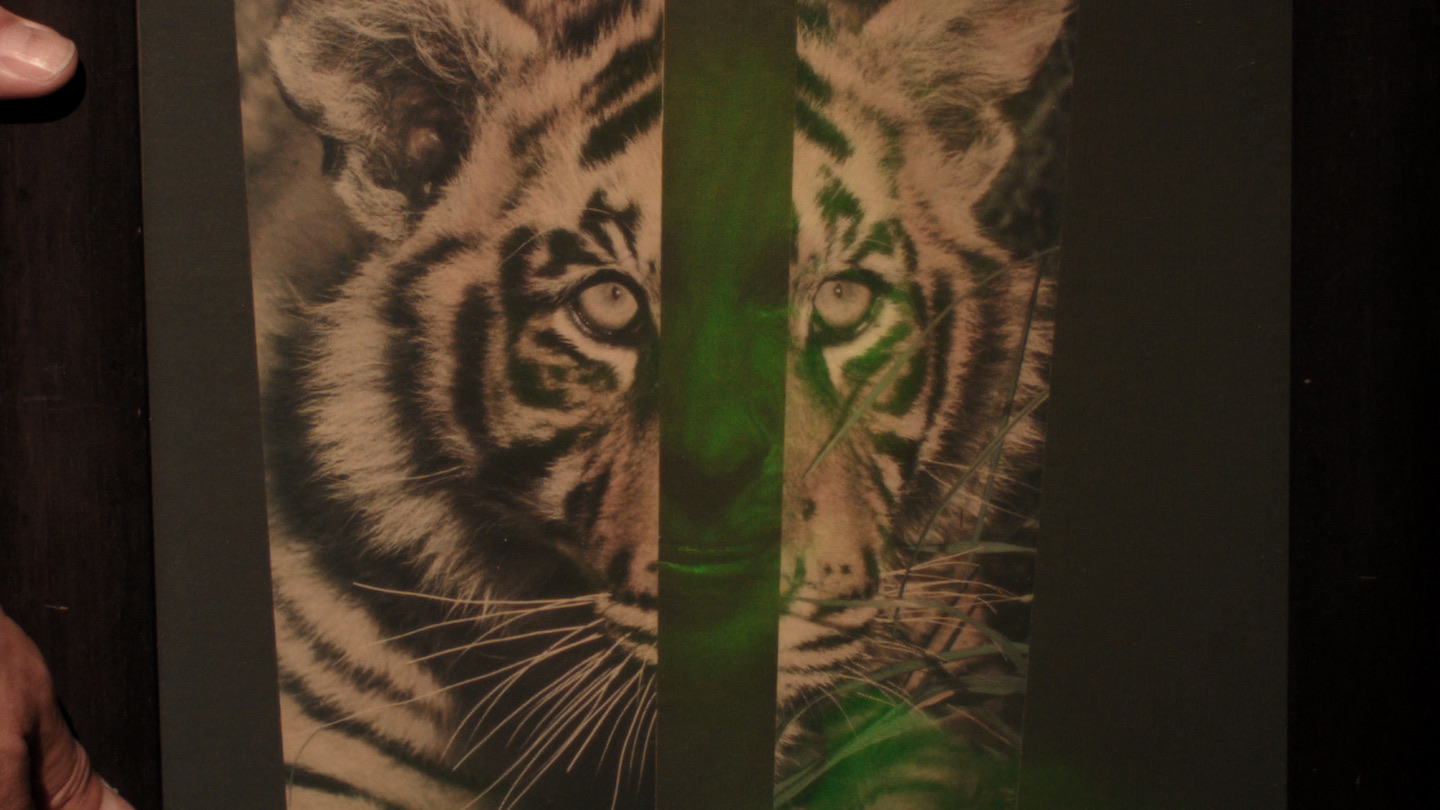Listen to the audio version of this essay on Soundcloud. (Listening time: 12 minutes)
An eye that follows a hand closely, passing on, and on, and on.
The gentle handling of teacups, warming themselves on the ceramic surface; a weave tugged out and pulled through cornrows with a comb, done toughly but with a tenderness held between two; a narration that accompanies an awkward seating, while two women discuss their lives and their memorialisation.
These images and many others become subjects of the gaze that defines the work of Anne-Marie Copestake. I want to write that it is a ‘fleeting’ gaze, though that, of course, does not do justice to the sensitivity employed in its looking. ‘Fleeting’ or ‘flighty’ are words we attach to things that are lacking in attention, that are distracted or perhaps distracting. It is not fleeting, nor flighty. It is curious and it treads carefully across many surfaces – surfaces of images and lives and relations that populate the artist’s surrounding world. Images appear and re-appear, the gaze returns to them, and in this repetition carries itself across these many gestures with something that is feeling and felt.
There is a closeness of images. They are often boundaried by the limits of the camera, filled with human bodies not recognizable in full, anonymized through the proximity by which they are documented. Documentation even seems too cold a word for such intimate observations. Observed.
Despite the assumed interiority of these observations the lived realities observed here both point to and are produced by their surrounding conditions. Precarity defines a common condition of lived-ness within this and preceding decades, and whilst precarity directly produces threats to our ability to live freely and well, it is a dynamic which also produces the ability to reach out across what might be considered realms of separation or difference, simply by pushing the human capacity of empathy, affect and love to term. Through the prism of precarity, and experiences that are touched by it, Copestake’s practice affords us an experience with means of storytelling that leads us towards inferred and almost-present happenings, rather than any kind of identity that is too fixed or too clear. Precarity both exists as a material reality in these films and contextualises them – with A Blemished Code (2019) the portrait of the holographic artist Margaret Benyon, being contextualised by the selling off of experimental holographic equipment by the Royal College of Art in the decades following her research. There is a sense that spaces and resources are prone to, or close to collapse, but that love or loves still manage to proliferate. Or that love or loves have to find ways to allow themselves to proliferate.
In A love (2019), the manner by which Copestake’s gaze memorializes this action, this gesture of love, is not through grandiosity nor by declaration, but instead occurs through the artist’s engagement with scenes of the everyday.
We begin with a warm hum and a hand spray-painting, perhaps in a garden, an unfurrowed field, then hands proliferate. They take care – combing and braiding hair; they write unseen notes on paper; they rest on the arms of themselves and others; they imitate an imagined off-screen, then put together hot sandwiches, handling baguettes and morning rolls; they sculpt clay and they work and they build; they roll along a snowball with woolen gloves, protecting themselves from the cold; they text as a soundtrack of staccato percussion imitates the click of a digital keyboard; they build fires; they dig through earth and unroot something rooted.

A love, Anne-Marie Copestake, 2019
In giving these intimate and small frames glimpses of such handiwork Copestake’s A love works to give dignity in its objectification of the characters we might imagine to form the constellation of beings observed here. It is an objectification that is not negative, in fact it is quite the contrary, Copestake’s hand moves deftly here in affording these gestures and processes attention in a loving and beautiful way. That the filming was undertaken in the artist’s own neighbourhood is little surprise, with a warmth and familiarity that allows the images compiled here to exceed their everydayness. Faces in the work are glimpsed barely, and when they are, only momentarily, the gestures and movements represented here, in becoming unstuck to a particular character or actor, proliferates infinitely onwards in an imagined world. Copestake’s presence is somewhat remote, and it allows these works to exemplify the possibility that there is no one correct way to do something, that the possibilities in human interaction require attention and concentration, but perhaps not assessment. Whilst Copestake’s afore-mentioned portrait of the holographic artist Margaret Benyon embraces a musicality in its score that meanders, expands and retracts and gives voice in some way to the ‘inner life of the subject’[1], A love’s musicality is found in voice, in hums, in quieter bodily movements.
In doing so, Copestake’s work here builds a portrait that is at times tentative and unwilling to portray the whole – we feel it as quiet hums of unfinished melodies from a woman’s voice, accompanying the throngs of musical drones before receding into the distance again. And whilst the surrounding context of the community that Copestake carefully looks upon-and-with may provide us with more understanding of the necessity of such intimacies, this approach also allows the work to create itself as a formal and material, if half-formed and potentially continuing thing. These contexts include; newly snowed upon streets; a neighbourhood home to many immigrant communities for generations; a social space that once played home to Glasgow’s Somali diaspora, now homeless; a hair salon.[2] In her attending to these co-habiting hands, these gestures that both signify and do labour, Copestake affords us a way of observing lived fictions, to imagine the continuing chains of relation that define such communities, and to realise that such future or imagined relations might be ‘already somehow present in them as a potential or resonance.’[3]
The potentials and resonances of such relations feel contained in A love, though in the earlier work, And Under That (2012), a series of narrations by two older women accompany a diversity of images, from tapestries hanging on a wall; police on horseback trotting through a dreich day; grey skies framed by leafless tree branches; a muddy puddle. What can be imagined in connecting this portrait-made-through-speaking of these two women and the images that proliferate across the screen is more unruly, and yet, as intimate. The intimacies, we can assume, are formed from relationships that expand before and will continue after the boundaries of such works.
Sometimes sound and image align – to show one of the two central figures playing her accordion on a leather chair later shown with a large cushion in the shape of a smiling, pink, cartoon daisy. The accordion sounds bleed over across an image of gorse flapping in the wind. In another moment a series of instruments next to a model of a skeleton human foot is described by the narrator, given to her by a family. She was a chiropodist as well as a trained psychoanalyst, and said to Copestake once that she was trained, from head to feet. The dialogue and images here build narratives, often unfinished, unresolved, but still existing with paths expanding outwards. Towards the beginning, one of the women tells us about a word,
‘It’s a note written on a scrap of paper. I keep seeing the word move. It looks as if it were written very quickly so I keep thinking it says more but each time it actually says move.’
And later,
‘I hear someone shouting CHIEF, or THIEF.’

And Under That, Anne-Marie Copestake, 2012.
Ambiguities layer themselves as this work continues in its building of a portrait through fragments. There are recollections that might be misremembered, fictions that might in some world have been realities, there are questions, both practical and practicable, as well as abstract, philosophical, asked without the intention of answering them. In one particularly poignant alignment, one of the women describes some time working as a window dresser, her unintentional beginning in the trade, but also the importance in such work of colour, form, balance in attracting the other, as Copestake’s gaze allows itself careful glimpses of details in a domestic interior – of full plastic storage boxes, of blinds and the sun through them, of coving details; of a bookshelf just out of focus.
We assume it is the home of the woman doing the talking, and so the imagining of relations continues. There is a sense that simply by bringing together biographical, historical and poetic fragments, And Under That has the potential to make these two women if not the centre of the universe, then at least the centre of a universe we can all imagine ourselves within. These women, whose whole, complete biographies are deliberately withheld from us as viewers become extraordinary in their own ordinary ways. They tell stories that are theirs but vibrate with the representation of a post-war generation who saw death and work and collapse and some kind of rebuilding. And spilling across the other films mentioned here we imagine rebuilding and regrouping, whether in the communities alluded to and referenced in these bodies of work; of Somalian women who largely came to Glasgow from their home as widows; of women’s histories told from their own mouths; of attempts at building a new vocabulary or method for image-making, frustrated by the institutions that ought to support it.
The ability in Copestake’s works to inhabit and document a diversity of images, voices, memories and fictions is a manner of looking which does not search deeply for relations between causes and symptoms, originator and signs. It is both a technique of documenting and creating a poetics of the social. The ‘fleeting’ gaze I attempted to describe earlier is not just a gaze that emerges from looking, but also touching, feeling. It does not make grand claims towards the transformative, but it does make many small transformations in the way we think and feel along with the images that become our companions in these works. It is a gliding along existing structures in an attempt not to unpick or reveal their underlying architecture, but to act and speak with, to memorialise and to trace, to bring them to a form that is more than simply lived.
[1] A quote communicated by Anne-Marie to myself, from Benjamin Cook’s introduction to the film at the London Film Festival.
[2] Marcus Jack on Anne-Marie Copestake’s A love, LUX Scotland
[3] Kathleen Stewart, ‘Weak Theory in an Unfinished World’, Journal of Folklore Research, 45: 1, pp. 71 – 82
Seán Elder is a curator, researcher and writer from the Scottish Highlands based in Birmingham, UK. They have worked with artists to develop events, writing and exhibitions for organisations including Jerwood Arts (London); BALTIC 39 (Newcastle); Grand Union (Birmingham); LUX Scotland (Glasgow); The WorM (Aberdeen). Elder was previously Associate Curator at Grand Union, and Writer-in-Residence at Cooper Gallery, Duncan of Jordanstone College of Art and Design, Dundee.






